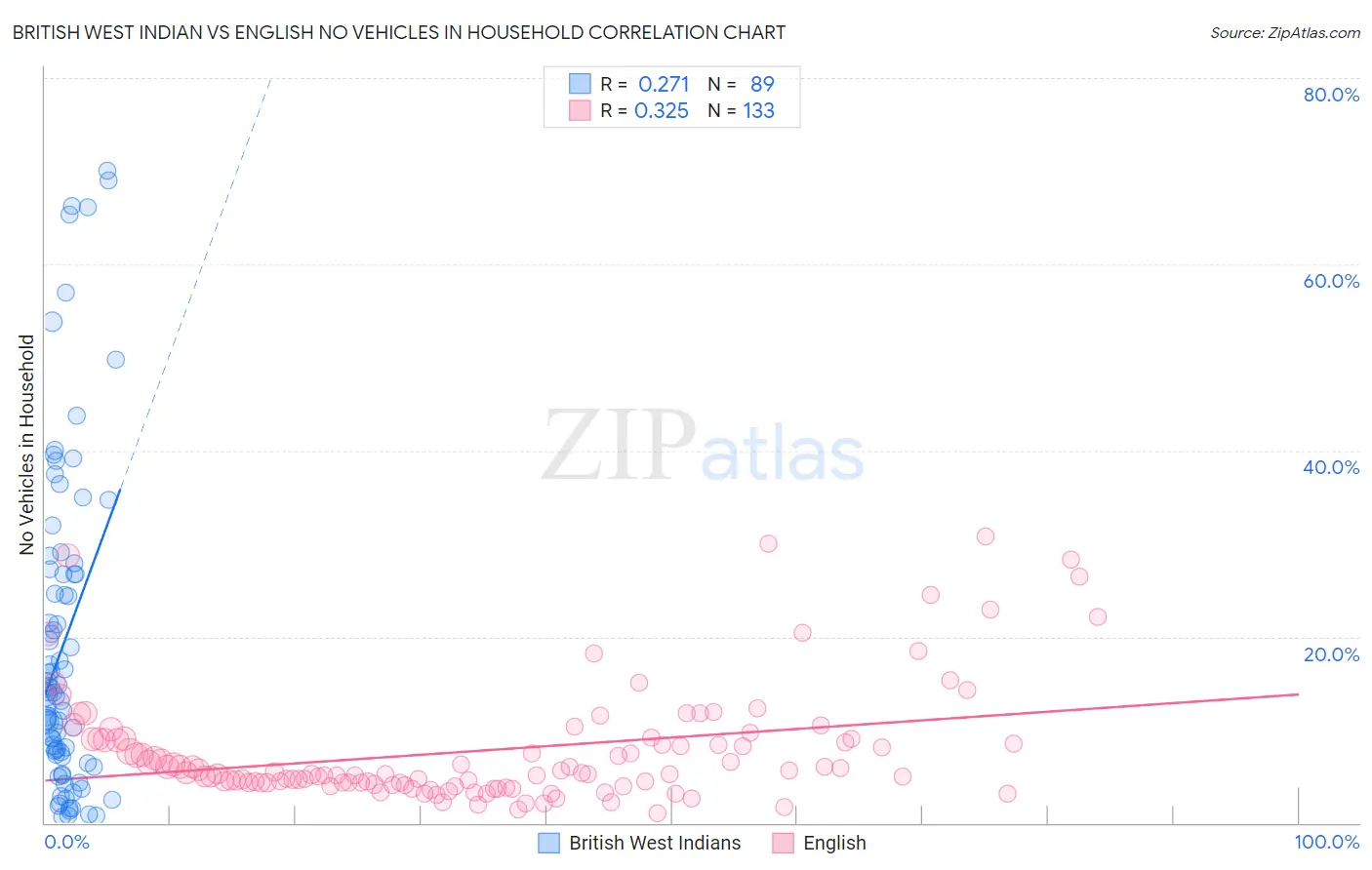British West Indian vs English No Vehicles in Household
COMPARE
British West Indian
English
No Vehicles in Household
No Vehicles in Household Comparison
British West Indians
English
29.7%
NO VEHICLES IN HOUSEHOLD
0.0/ 100
METRIC RATING
342nd/ 347
METRIC RANK
6.5%
NO VEHICLES IN HOUSEHOLD
100.0/ 100
METRIC RATING
3rd/ 347
METRIC RANK
British West Indian vs English No Vehicles in Household Correlation Chart
The statistical analysis conducted on geographies consisting of 152,511,245 people shows a weak positive correlation between the proportion of British West Indians and percentage of households with no vehicle available in the United States with a correlation coefficient (R) of 0.271 and weighted average of 29.7%. Similarly, the statistical analysis conducted on geographies consisting of 572,648,684 people shows a mild positive correlation between the proportion of English and percentage of households with no vehicle available in the United States with a correlation coefficient (R) of 0.325 and weighted average of 6.5%, a difference of 357.0%.

No Vehicles in Household Correlation Summary
| Measurement | British West Indian | English |
| Minimum | 0.70% | 1.0% |
| Maximum | 70.0% | 30.8% |
| Range | 69.3% | 29.8% |
| Mean | 19.4% | 7.8% |
| Median | 14.1% | 5.3% |
| Interquartile 25% (IQ1) | 7.2% | 4.3% |
| Interquartile 75% (IQ3) | 27.0% | 9.0% |
| Interquartile Range (IQR) | 19.9% | 4.7% |
| Standard Deviation (Sample) | 17.5% | 6.1% |
| Standard Deviation (Population) | 17.4% | 6.1% |
Similar Demographics by No Vehicles in Household
Demographics Similar to British West Indians by No Vehicles in Household
In terms of no vehicles in household, the demographic groups most similar to British West Indians are Inupiat (29.9%, a difference of 0.41%), Immigrants from Guyana (29.5%, a difference of 0.85%), Immigrants from Barbados (29.5%, a difference of 0.90%), Dominican (29.4%, a difference of 1.1%), and Guyanese (29.3%, a difference of 1.5%).
| Demographics | Rating | Rank | No Vehicles in Household |
| Immigrants | Trinidad and Tobago | 0.0 /100 | #333 | Tragic 24.6% |
| Immigrants | Bangladesh | 0.0 /100 | #334 | Tragic 25.8% |
| Barbadians | 0.0 /100 | #335 | Tragic 26.1% |
| Vietnamese | 0.0 /100 | #336 | Tragic 26.2% |
| Immigrants | Uzbekistan | 0.0 /100 | #337 | Tragic 26.7% |
| Guyanese | 0.0 /100 | #338 | Tragic 29.3% |
| Dominicans | 0.0 /100 | #339 | Tragic 29.4% |
| Immigrants | Barbados | 0.0 /100 | #340 | Tragic 29.5% |
| Immigrants | Guyana | 0.0 /100 | #341 | Tragic 29.5% |
| British West Indians | 0.0 /100 | #342 | Tragic 29.7% |
| Inupiat | 0.0 /100 | #343 | Tragic 29.9% |
| Immigrants | Dominican Republic | 0.0 /100 | #344 | Tragic 31.4% |
| Immigrants | St. Vincent and the Grenadines | 0.0 /100 | #345 | Tragic 35.4% |
| Immigrants | Grenada | 0.0 /100 | #346 | Tragic 37.5% |
| Yup'ik | 0.0 /100 | #347 | Tragic 45.9% |
Demographics Similar to English by No Vehicles in Household
In terms of no vehicles in household, the demographic groups most similar to English are Norwegian (6.4%, a difference of 1.1%), Danish (6.6%, a difference of 1.2%), Yakama (6.6%, a difference of 1.6%), German (6.7%, a difference of 2.6%), and Scottish (6.8%, a difference of 3.9%).
| Demographics | Rating | Rank | No Vehicles in Household |
| Luxembourgers | 100.0 /100 | #1 | Exceptional 5.4% |
| Norwegians | 100.0 /100 | #2 | Exceptional 6.4% |
| English | 100.0 /100 | #3 | Exceptional 6.5% |
| Danes | 100.0 /100 | #4 | Exceptional 6.6% |
| Yakama | 100.0 /100 | #5 | Exceptional 6.6% |
| Germans | 100.0 /100 | #6 | Exceptional 6.7% |
| Scottish | 100.0 /100 | #7 | Exceptional 6.8% |
| Swedes | 100.0 /100 | #8 | Exceptional 6.8% |
| Scotch-Irish | 100.0 /100 | #9 | Exceptional 6.8% |
| Dutch | 100.0 /100 | #10 | Exceptional 6.8% |
| Czechs | 100.0 /100 | #11 | Exceptional 6.9% |
| Assyrians/Chaldeans/Syriacs | 100.0 /100 | #12 | Exceptional 7.0% |
| Scandinavians | 100.0 /100 | #13 | Exceptional 7.0% |
| Mexicans | 100.0 /100 | #14 | Exceptional 7.0% |
| Whites/Caucasians | 100.0 /100 | #15 | Exceptional 7.0% |